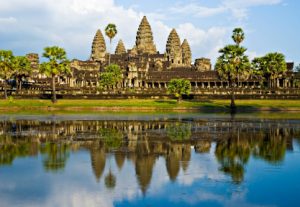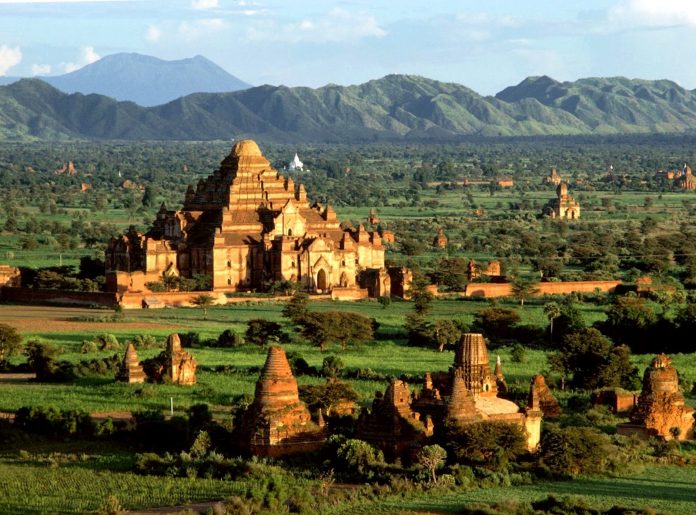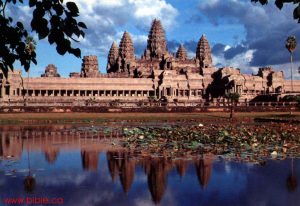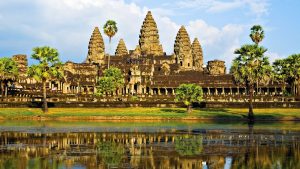History of Cambodia – Country lying on the Gulf of Siam in S Indochina, bordered by Vietnam to the E, Thailand to the W, and Laos to the N. The navigable Mekong River roughly bisects the country, and its fertile flood plains provided the basis for the extensive agricultural wealth that supported the country’s former greatness.
Cambodia’s prehistory is cloudy, but it seems that successive waves of people passed through the area and left farm villages along its watercourses. Metal working was present, possibly as early as the fourth century b.c.
The first major culture was that of Funan, which flourished between the first and sixth centuries a.d. and derived much of its prosperity and culture from its position on the great trade route between India and China. Funan was absorbed by the rising Hindu state of Chen La by the beginning of the seventh century. Chen La was headed by the Khmers, whose home area was in the middle Mekong region of modern Laos. Their rule began to flourish in Angkor, after Chen La’s demise, under the leadership of Jayavarman II (802–50) and his successors. The concept of a unified national state of Cambodia was then set in the Khmer consciousness for the first time and has since remained constant.

Jayavarman II and succeeding Khmer monarchs developed a new state religion in which the ruler was a god-king with great power. Under them Cambodia was transformed with the construction of vast irrigation systems that allowed dense populations, and there was tremendous building in the Angkor region. Yasodharapura covered 16 square miles, with extensive water supply systems. Through the 12th century the Khmers expand ed in power and territory. Suryavarman II (1113–50) pressed Vietnam and had a major influence on Thailand and the Malay Peninsula. He instituted tremendous building projects, including Angkor Wat, Beng Meala, and Bunteay Samre. After his death, Champa, which had been controlled by the Khmers in spite of continual rebellion, freed itself and began a long series of skirmishes that climaxed in the capture of Angkor in 1177 and the death of the new Khmer ruler, leaving the country in chaos. In 1181, Jayavarman VII became king, resubjugated the Chams, and began an enormous and costly campaign of temple building that created Angkor Thom. The kingdom’s resources were sorely strained, and after his death the Khmer empire began a long decline.
Siam began to dominate the region, and Angkor fell to its attacks in 1369, 1389, and finally in 1444, which led to its aband onment. The Khmers moved the royal capital to Phnom Penh and continually lost power and influence. Siam continued its successful expansion, and from 1596 to 1603 Cambodia was ruled by Spanish troops that had been brought in to help defend the country. Cambodia continued to decline throughout the 17th and 18th centuries and suffered under vassalage to both Vietnam and Siam. France came into control of Cambodia as an outgrowth of colonial expansion in Vietnam, and in 1863 forced King Norodom to sign a treaty establishing a French protectorate.
In 1884 the French forced Cambodia’s acceptance of colonial status and after putting down a two-year rebellion they consolidated their power. Cambodia was quietly governed by the French until World War II when Japan occupied it without causing traumatic change. In 1953 Prince Norodom Sihanouk took advantage of France’s preoccupation with the First Indochinese War to successfully petition for a grant of independence. In the Second Indochinese War Sihanouk moved toward alliance with North Vietnam and China, seeing the traditional enemies, South Vietnam and Thailand , as his chief threats. He was overthrown in 1970, after U.S. air attacks on Cambodia and anti-Vietnamese riots. Under Lon Nol’s rule Cambodia fought Hanoi-backed rebels with U.S. aid until Phnom Penh was captured by the revolutionary forces of Pol Pot in 1975. The country’s name was then changed to Kampuchea. A reign of mass execution of millions, population relocation, and upheaval aimed at forcibly returning the country to its agrarian past then removed the country from the view of the rest of the world. In 1979 a Vietnamese- controlled insurgent force seized control of Cambodia, and the Vietnamese army followed. However, Prince Sihanouk, now allied with the remnants of the Pol Pot forces, attempted to reinstate an anti-Vietnam, Cambodian regime in the country.
The Vietnamese withdrew in 1989, leaving the pro- Vietnam Cambodian government of Prime Minister Hun Sen to face a rebel coalition (including the Khmer Rouge) supported by China and Thailand . In 1991 all groups agreed to a cease-fire, and to UN-supervised elections. Prince Sihanouk denounced the Khmer Rouge, aligned himself with Hun Sen, and became once again the head of state. The Khmer Rouge withdrew from the peace process and resumed a guerilla war against the government. Further UN-sponsored elections in 1993 led to a new constitution, which re-established the monarchy, with Sihanouk again taking the throne of the Kingdom of Cambodia. During the period 1993–94 a government sponsored amnesty resulted in a wave of defections from the Khmer Rouge.
A fragile co-premier coalition government of the National United Front, headed by Sihanouk’s son Prince Ranariddh, and Hun Sen’s Cambodian People’s Party finally led to open conflict in July 1997, when Hun Sen alleged that Ranarridh was merging Khmer Rouge defectors into his ranks. After a weekend of fighting in Phnom Penh, Hun Sen emerged as the sole leader. Hun Sen became the prime minister after the 1998 elections. Pol Pot was confirmed dead in April 1998, which marked the end of the Khmer Rouge’s power.







